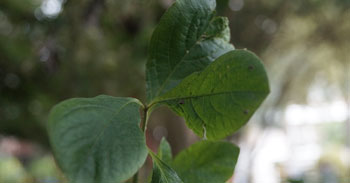KJC Medicinal Garden
Uttaraani
Achyranthes aspera
Order: Caryophyllales
Family: Amaranthaceae
Genus: Achyranthes
Species: A. aspera
Common Names: Chaff-flower, Prickly chaff flower, Devil's horsewhip
Native to Distributed throughout the tropical world
Other plants of the same genus with medicinal properties
-
A. bidentata
A. aspera
- Achyranthes aspera is an erect, sometimes sprawling, long-lived herb which can grow up to 2 m tall, with stems becoming woody at the base.
- Its short-stalked leaves are opposite, simple and egg-shaped; they can be densely to sparsely hairy and are dark green above and paler below, with young leaves often silvery.
- The small greenish-white flowers, often tinged with purple-red, form terminal spikes, dense at first but elongating up to 60 cm long. As the flowers age, they bend downwards and become pressed closely against the stem.
- The fruits are small one-seeded capsules, orange to reddish purple or straw-brown; with their pointed tips, they readily adhere to animals and clothing.
- This is a slender, erect, and multi-branched herb up to ~2 m.
Uses in Tradition systems of medicine
- The pulp of fresh Achyranthens Aspera leaves, and flowering spikes is an effective home remedy for scorpion bites when applied externally, which is believed to paralyze.
- For snake/reptile bites, the seeds are beneficial for ophthalmic diseases and other corneal infections.
- Flowering, elongated spikes mix with little sugar and used in mad dog bites to treat hydrophobia.
- Achyranthens Aspera ash loaded with potash has been used for washing clothes.
- Flowers and fruits of Achyranthens Aspera are useful for the treatment of menorrhagia.
- Achyranthes Aspera plant and seeds are rich in carbohydrates, proteins, and bioactive constituents such as flavonoids, tannins, and saponins that help maintain an individual’s overall health.
Suggested Medicinal Properties
- Achyranthes aspera also possesses activities like antiperiodic, diuretic, purgative, laxative, antiasthmatic, hepatoprotective, anti-allergic, antifertility, laxative, abentifacient, anti-helminthic, aphrodisiac, antiviral, anti-plasmodic, hypoglycemic, antihypertensive, anticoagulant, anticancer and various other important medicinal properties.
Active Phytochemicals
• Carbohydrates:
The leaf extracts of petroleum ether, chloroform and methanol responds positively to Molish and Anthrone test where as the other flower extracts showed negative results
• Protein and Amino acids:
All the extracts responded negatively to Ninhydrin acid indicating absence of protein in the extracts
• Steroids:
only leaf and flower extracts of petroleum ether and leaf extract of methanol displayed positive response to all the other extracts showed negative result
• Phenolic compound:
Phenolic compound was detected by Ellagic acid test and phenol test to be present in only the leaf extract of methanol and absent in the rest.
• Glycosides:
Tests for glygosides by Kellar Kiliani and Sulphuric acid test revealed presence in leaf and flower extracts of petroleum ether, leaf extracts of chloroform and methanol and absence in other extracts
• Saponin:
foam test for detection of saponin revealed presence of saponins in flower extracts of petroleum ether and chloroform and leaf extract of methanol only the other extracts responded negatively to the foam test
• Tannins: leaf extracts of all the three solvents and flower extract of methanol responded positively to FeCl3 test
• Alkaloids:
Drangendroff test and Mayer’s test revealed the presence of alkaloids in only the leaf and flower extracts of methanol where as absence in petroleum ether and chloroform extracts.
• Flavonoids:
lead acetate test revealed absence of flavonoids in all the extracts
References
1. "Achyranthes aspera". Germplasm Resources Information Network (GRIN). Agricultural Research Service (ARS), United States Department of Agriculture (USDA). Retrieved 2018-01-02.
2. Khan, A. V. and A. A. Khan. Ethnomedicinal uses of Achyranthes aspera L. (Amaranthaceae) in management of gynaecological disorders in western Uttar Pradesh (India). Archived November 24, 2010, at the Wayback Machine Ethnoleaflets.
3. Indian Herbal Pharmacopia Vol. II, Page-5.

